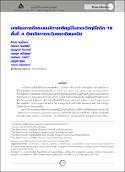บทคัดย่อ
การวิจัยผสานวิธีครั้งนี้มีวัตถุประสงค์เพื่อศึกษา บทเรียนการจัดระบบบริการตติยภูมิในภาวะวิกฤติโควิด-19 พื้นที่ 4 จังหวัดในภาคตะวันออกเฉียงเหนือ ใช้กรอบ health-care capacity and utilization และ six building blocks ศึกษาในโรงพยาบาลตติยภูมิของจังหวัดขอนแก่น อุดรธานี สุรินทร์และอุบลราชธานี ผู้ให้ข้อมูลคือ ผู้บริหารระดับเขตสุขภาพ จังหวัด โรงพยาบาล คณะกรรมการโควิด บุคลากรทางการแพทย์ งานสิ่งแวดล้อมและประชาชนผู้มีส่วนได้ส่วนเสีย ระหว่างเดือนกันยายน 2564 ถึงเดือนกุมภาพันธ์ 2565 เครื่องมือที่ใช้เป็นแบบประเมินการบริหารจัดการระบบบริการสุขภาพ แบบสัมภาษณ์เชิงลึก การอภิปรายกลุ่ม ถอดบทเรียน วิเคราะห์ข้อมูลเชิงปริมาณด้วยสถิติ ร้อยละและค่าเฉลี่ย วิเคราะห์ข้อมูลเชิงคุณภาพด้วยการวิเคราะห์เนื้อหาผลการวิจัย พบบทเรียนการจัดระบบบริการตติยภูมิในภาวะวิกฤติโควิด-19 พื้นที่ 4 จังหวัดที่ประสบความสำเร็จ ดังนี้ 1) มีคณะกรรมการ emergency operation center (EOC) ระดับจังหวัด เป็นแกนนำหลักที่สำคัญ 2) ผู้บริหารและผู้ปฏิบัติต้องร่วมคิด ร่วมทำ ร่วมจัดการ ร่วมรับผิดชอบ 3) ภาคีเครือข่ายทุกภาคส่วนหนุนเสริมความร่วมมือในการบริหารจัดการ 4) นำเทคโนโลยีสารสนเทศมาใช้เพื่อการตัดสินใจของผู้บริหาร 5) ยึดหลักการคัดกรองโควิด-19 ด้วยหลัก รู้เร็ว แยกเร็ว กักเร็วและรักษาเร็ว 6) เตรียมความพร้อมกรอบอัตรากำลังของบุคลากร 7) ให้ความสำคัญกับการพัฒนาสมรรถนะของบุคลากรให้พร้อมในรูปแบบพี่สอนน้อง เพื่อนช่วยเพื่อน เครือข่ายช่วยกัน 8) ใช้หลัก SMART กับการบริหารจัดการ 9) ส่งต่อผู้รับบริการแบบไร้รอยต่อ และ 10) ให้ความรู้ ความเข้าใจต่อแนวทางปฏิบัติสำหรับผู้ปฏิบัติและผู้รับบริการ ซึ่งโรงพยาบาลตติยภูมิสามารถนำไปใช้ในการประยุกต์ตามบริบทของพื้นที่ได้อย่างมีประสิทธิภาพต่อไป
บทคัดย่อ
The objective of this mixed-method research was to study the lessons learned from organizing health service systems at the tertiary level in the northeastern region of Thailand during the critical pandemic of COVID-19. The study focused on the health care capacity and utilization and the six building blocks frameworks, examining the tertiary hospitals in Khon Kaen, Udon Thani, Surin, and Ubon Ratchathani in the northeastern region of Thailand. The data sources included health region administrators, provincial and hospital managers, COVID-19 committees, medical personnel, environmental workers, and stakeholders from the community. The research was conducted from September 2021 to February 2022, using health-care capacity and utilization assessment tools including in-depth interviews, focus group discussions, and lesson learned extraction. Quantitative data were analyzed using percentages and averages, and qualitative data by content analysis. The research findings plus lessons learned were as follows. 1) The emergency operation center committee’s province played a crucial leadership role. 2) Managers and practitioners collaborated, participated, managed, and took responsibility together. 3) Intersectoral networks supported cooperation and resource sharing. 4) Information and communication technology was used for decision-making by managers. 5) The screening principles for COVID-19 of rapid knowing, detecting, isolating, quarantining, and treating were followed. 6) Preparedness of personnel capacity framework. 7) Competency development of personnel through mentorship, peer support, and networking. 8) Employed SMART principle in management and administration. 9) Enforced seamless referral of patients. 10) Provided knowledge and understanding to practitioners and service recipients. These lessons learned could be effectively applied to tertiary hospitals in future contexts.


